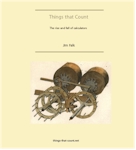 Things
that Count: the rise and fall of calculators Things
that Count: the rise and fall of calculators
By Professor Jim Falk
Professorial Fellow, Melbourne Sustainable Society Institute, University of Melbourne
Visiting Professor, United Nations University, Institute of Advanced Studies
|
|
|
|
|
| How Computers Do Math by Clive "MAX" Maxfield and Alvin Brown Wiley-Interscience - ISBN: 0471732788 "Festooned with nuggets of information and tidbits of trivia, our book How Computers Do Math provides an incredibly fun and interesting introduction to the way in which computers perform their magic in general and how they do math in particular (check out the contents).
How Computers Do Math can be enjoyed by non-technical individuals; students of computer science, electronics engineering, and mathematics; and even practicing engineers (to name but a few). All of the illustrations and interactive laboratories featured in the book are provided on the CD-ROM for use by high-school, college, and university educators as lecture notes and handouts. " Clive Maxfield and Alvin Brown |
 Collector's Guide to Pocket Calculators Collector's Guide to Pocket Calculators
by Bruce Flamm, Guy D Ball the world's only comprehensive guide book to collecting of early electronic calculators. The book includes: Over 450 photos. Exclusive details about rare calculators from Russian and Europe. Concise historical summary of 1960s and 1970s calculator developments. How to find desirable calculators at the best prices. 16 pages of 1970s-vintage advertisements. Original pricing and dating of many models. |
 The Calculating Machines (Die Rechenmaschinen : Their History and
Development) The Calculating Machines (Die Rechenmaschinen : Their History and
Development) by Ernst Martin This volume, the 16th and last in the current series of reprints, is translated from the German original of 1925 and provides a very fine picture of the state of the mechanical calculator industry in 1925. After an introduction that describes the seven major types of machines that had been produced by 1925, Martin offers a list of specific makers, arranged by the date when they first patented or produced a calculating machine, and a quite detailed description of the devices themselves, many of which are illustrated. Annotation copyright Book News, Inc. Portland, Or. Booknews, Inc. , October 1, 1992 |
| Office Collectibles : 100
Years of Business Technology by Thomas A. Russo Hardcover (June 2000) Schiffer Publishing, Ltd.; ISBN: 0764311778 This is a 224 page book, all color and printed on heavy stock (it weighs 31/4 pounds). It covers a large variety of office equipment, including typewriters, pencil sharpeners, calculators, etc. Most (if not all) of the examples are in Tom's extensive and major collection. There are 18 pages on calculators showing a total of 34 different machines. There are no slide rules. It does contain a price guide. If you own any of the calculators shown in the book, you will be happy: his prices are substantial. This is a handsome book with a wealth of interesting material. It is not a book for someone desiring a detailed list of every model of every calculator ever made. I have enjoyed reading it, and look forward to the next two books in the series (as I understand it, there will be a total of three); one is entirely on calculators, and the other entirely on typewriters. Bob Otnes |
| Glory and Failure : The Difference Engines of Johann Muller,
Charles Babbage, and Georg and Edvard Scheutz (History of Computing) by Michael Lindgren, Craig G. McKay (Translator) - 1990. |